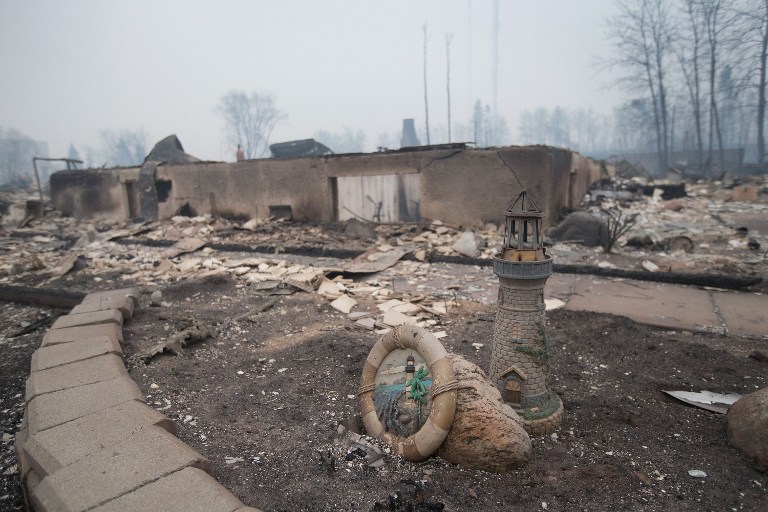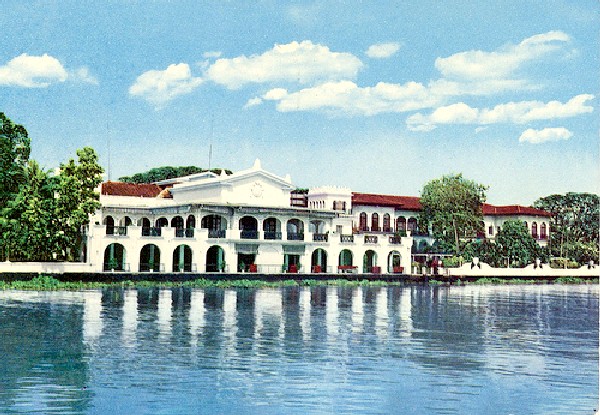
by Michel COMTE
FORT MCMURRAY, CANADA (AFP) –– Authorities battling a forest fire in Canada looked to Mother Nature for more help Monday, as cooling temperatures and rain slowed the spread of the blaze that had forced the evacuation of an entire city.
There was more good news too, with the amount of land charred less than originally feared and the last of 25,000 people trapped north of Fort McMurray in Alberta province safely evacuated in road convoys through the ruined oil city.
Oil facilities have escaped major damage, officials said, and there have been no fatalities directly linked to the blaze.
Alberta premier Rachel Notley and other officials said the fires raging for days around Fort McMurray were moving “much, much more slowly” thanks to a bit of rain and cooler temperatures.
Authorities had worried the fire could spread east to Saskatchewan province, but Notley said that had not happened yet.
The fire’s eastern edge was 40 kilometers (25 miles) from Saskatchewan and estimates of the area destroyed were lowered from 2,000 square kilometers (772 square miles) to about 1,600 square kilometers.
The ruthless blaze, fanned by high winds and fueled by tinder-dry conditions, devastated Fort McMurray and the region around it. The city was home to 100,000 until it was evacuated last week as flames burned homes to the ground amid scenes of panic and mass exodus.
Chad Morrison, senior wildfire manager for Alberta, said Sunday that favorable weather conditions and the hard work of about 500 firefighters had contained most fire lines in Fort McMurray.
The threat to oil-sand mines north of the city had also diminished, at least for now, he said.
Morrison said fire lines had moved away from the work sites of Nexen, a unit of the Chinese group CNOOC, after inflicting only minor damage.
Work sites of the Suncor petroleum group, which suspended operations in the area, had also been spared.
The company said Sunday it had moved 10,000 people including employees, their families and local residents to safety.
– ‘The beast’ –
Morrison said firefighters hoped rains and cooler temperatures predicted for Monday and winds from the west, gusting up to 60 kilometers per hour (35 mph), would keep the flames away from the petroleum work camps in coming days.
Even as fellow Canadians rally to provide succor and support, thousands of evacuees are coming to terms with the likelihood that they will be unable to see their homes anytime soon — assuming the dwellings are still standing.
Hundreds of firefighters, exhausted and demoralized after days vainly battling a blaze they grimly refer to as “the beast,” acknowledged that they will probably have to wait for the fire to burn itself out.
The Alberta oil sands are a vital part of the regional economy.
Huge swaths of forest and brush, as well as whole neighborhoods of the city, have been turned to ash in an area three-quarters the size of Luxembourg.
Firefighters are concentrating on saving vital infrastructure including telecommunications, electric grids, gas and water lines.
Rescue crews and police have been guarding the city, but it will be days before workers can begin clearing damaged or destroyed structures and residents can begin to move back into areas spared by the inferno.
Notley said late Saturday that gas lines had been cut, the electric grid damaged and a large part of the city had neither electricity nor drinkable water.
“There’s a great deal of hazardous material to be cleaned up, and many other things to be done before the city is safe for families to go home,” she said.
Most of the 100,000 evacuees have found temporary shelter with friends or family, but the government is working furiously to provide accommodations for the others.
– ‘We’re safe’ –
In Lac La Biche, the first big town south of the forbidden zone, cases of mineral water, clothes and food provided by the Red Cross or donated by fellow Canadians are being distributed by volunteers.
“It’s just amazing to see what’s been done. We’re overwhelmed, everybody’s overwhelmed with how much the whole country has supported us,” said Sarah, who evacuated with her family without knowing where they would end up.
“I’ve said to my daughter the whole way up here, the most important thing is that we’re here, we’re safe, and everything else is just stuff,” she told AFP.
Notley said large numbers of evacuees could be housed for now in university dormitories in Edmonton or Calgary — students left days ago when their spring term ended.
Across the province, more than 1,400 firefighters, about 133 helicopters, 200 pieces of heavy equipment and more than 27 air tankers are battling 43 separate blazes.
Reduced output by Alberta’s oil producers — down by a million barrels a day — contributed to a rise in crude prices in trading Monday in Asia.
© 1994-2016 Agence France-Presse








